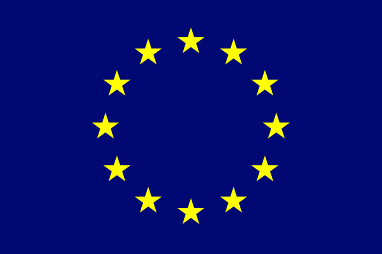Quality and Accountability initiatives VOICE commits to!
VOICE Members are traditionally committed to The SPHERE standards
40 VOICE members hold a membership with the Core Humanitarian Standard Alliance
12 VOICE members are certified against Core Humanitarian Standard
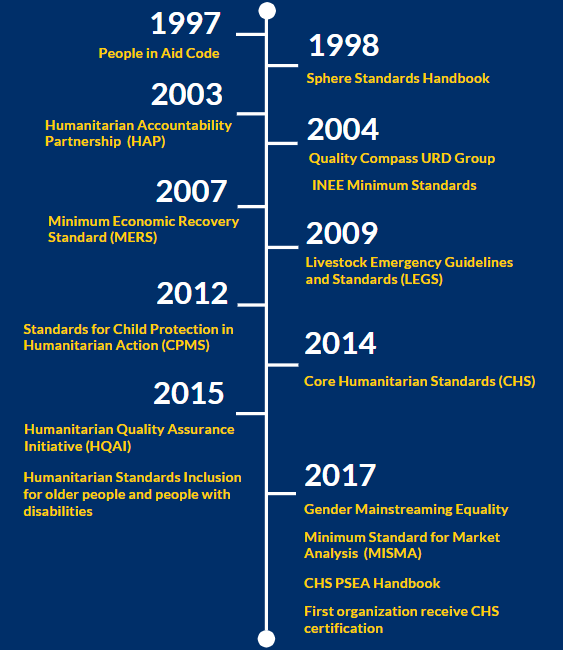 During the past decades, the humanitarian sector has developed and improved a number of voluntary quality and accountability initiatives through standards, guidelines, and indicators to reinforce technical quality and accountability of humanitarian operations. Established through a collaborative process among different stakeholders, the application of these initiatives represents a watershed to the sector in a time of reflection on aid agencies to demonstrate stronger accountability towards affected populations, aid community, and donors. Despite having different mandates, constituencies and structures in technical areas, they share a common goal and are complementary to one another.
During the past decades, the humanitarian sector has developed and improved a number of voluntary quality and accountability initiatives through standards, guidelines, and indicators to reinforce technical quality and accountability of humanitarian operations. Established through a collaborative process among different stakeholders, the application of these initiatives represents a watershed to the sector in a time of reflection on aid agencies to demonstrate stronger accountability towards affected populations, aid community, and donors. Despite having different mandates, constituencies and structures in technical areas, they share a common goal and are complementary to one another.
VOICE members are strongly committed to international quality and accountability initiatives when responding to humanitarian crises for a more sustainable impact on the lives of affected populations and towards its implementing partners and staff. They have been at the forefront of developing, supporting and integrating quality initiatives into their humanitarian work.
VOICE as a network aims to support members’ access to tools, information, and resources related to developing quality assurance systems relevant to their humanitarian work. VOICE members’ concern with the quality of humanitarian aid underpins the network’s objective of principled humanitarian action.
INITIATIVES
Core Humanitarian Standard on Quality and Accountability (CHS)
 Established in 2014, the CHS sets out nine commitments to be used for the purpose of improving both the quality and effectiveness of assistance. The CHS brings together, and has replaced, the 2010 HAP International, People In Aid Code of Good Practice, the Core Standards section of the Sphere Handbook, and Groupe URD’s Quality COMPAS reference framework.
Established in 2014, the CHS sets out nine commitments to be used for the purpose of improving both the quality and effectiveness of assistance. The CHS brings together, and has replaced, the 2010 HAP International, People In Aid Code of Good Practice, the Core Standards section of the Sphere Handbook, and Groupe URD’s Quality COMPAS reference framework.
The CHS Alliance facilitates and assists its members and the wide humanitarian community to promote the CHS standards across their organization and in relation to the sector. To assess progress and analyze the differences the Alliance developed three procedures: CHS self-assessment part of CHS Alliance Membership requirements which follows a two-year cycle; certification, a four-year process which attests and asses the organization’s actual compliance against the CHS requirements; independent verification, also has a four-year cycle but with the aim to generate a comprehensive analysis of an organization’s on-going improvement in the application of the CHS; peer review, a two-year cycle for organizations that want an assurance that their peer organization is implementing the CHS. The late has not been field tested.
Humanitarian Quality Assurance Initiative (HQAI)
 The HAQI is a mechanism established in 2015 to fill in the gap within the humanitarian community by offering independent quality assurance services. The initiative has developed robust tools to measure efficiently where an organization stands in relation to the nine CHS commitments. The CHS certificate by HQAI has a four years validation period with a yearly audit to assess the continuing compliance with the requirements. The independent verification is a four-year process that assesses the continuous improvement as per a developed work plan and not to assess the full conformity towards the CHS.
The HAQI is a mechanism established in 2015 to fill in the gap within the humanitarian community by offering independent quality assurance services. The initiative has developed robust tools to measure efficiently where an organization stands in relation to the nine CHS commitments. The CHS certificate by HQAI has a four years validation period with a yearly audit to assess the continuing compliance with the requirements. The independent verification is a four-year process that assesses the continuous improvement as per a developed work plan and not to assess the full conformity towards the CHS.
Currently, HQAI offers independent certification and verification only against the CHS. Tools related to other standards will be developed in the future.
 The first version of the Sphere Handbook was developed in 1997 through a broad and consensus-based consultative process within the humanitarian sector. It is a voluntary and self-regulatory initiative that aims at improving the quality and accountability of assistance.
The first version of the Sphere Handbook was developed in 1997 through a broad and consensus-based consultative process within the humanitarian sector. It is a voluntary and self-regulatory initiative that aims at improving the quality and accountability of assistance.
Sphere is one of the first initiatives aiming at improving the quality and accountability through a set of principles and universal minimum humanitarian standards in four technical areas of humanitarian response: Water supply, sanitation and hygiene promotion (WASH), food security and nutrition, shelter and settlement, and health. Today, the handbook is a collection of the standards and its foundational documents – the Humanitarian Charter, the Protection Principles, and the Core Humanitarian Standards.
The Minimum Standards for Child Protection in Humanitarian Action (CPMS)
 The CPMS was established in 2012 by members of the Global Child Protection Working Group which works within the Global Protection Cluster. In 2016, the working group transitioned to an interagency group called The Alliance to ensure humanitarian organizations meet agreed standards of quality programming.
The CPMS was established in 2012 by members of the Global Child Protection Working Group which works within the Global Protection Cluster. In 2016, the working group transitioned to an interagency group called The Alliance to ensure humanitarian organizations meet agreed standards of quality programming.
The CPMS is voluntary and accompanied by key actions, measurements and guidance notes. It was developed with the aim to establish common principles among those working in child protection, quality in programming, accountability, synthesis of good practices, and better advocacy and communication on child protection risks, needs, and responses.
Minimum Standard for Market Analysis (MISMA)
 Last revised in 2017, the MISMA is a market-specific standard developed by the Cash Learning that builds on CaLP research in market analysis given the increasing use of market-based programming and cash transfer programming across sectors.
Last revised in 2017, the MISMA is a market-specific standard developed by the Cash Learning that builds on CaLP research in market analysis given the increasing use of market-based programming and cash transfer programming across sectors.
The MISMA is built on the principle that market analysis should increase the quality of humanitarian response and limit potential harm. The standard covers five key actions of market analysis that informs the design and implementation of appropriate interventions using and supporting local markets. Due to its multi-sectoral nature, MISMA key actions are applicable to all the technical sectors.
Minimum Economic Recovery Standards (MERS)
 The MERS was created by the SEEP Network which seeks to develop resilient markets and enhance the livelihood potential of vulnerable populations. Last revised in 2017, the MERS is a tool for economic recovery programs in a humanitarian context.
The MERS was created by the SEEP Network which seeks to develop resilient markets and enhance the livelihood potential of vulnerable populations. Last revised in 2017, the MERS is a tool for economic recovery programs in a humanitarian context.
MISMA and MERS primary content are aligned, but the MERS goes into greater detail regarding the implementation of economic recovery activities and includes household economies and broader economic constraints within the market analysis. MERS handbook sets out strategies and responses that aim at livelihoods and enterprise support, job creation or financial services, encouraging the re-start of enterprises and improving market productivity and governance.
Livestock Emergency Guidelines and Standards (LEGS)
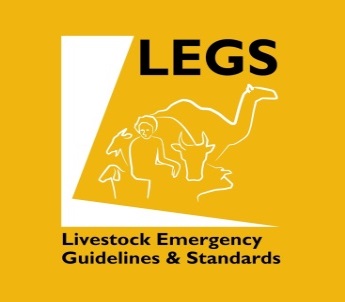 The LEGS Project is overseen by an international Steering Group, which provides strategic direction and quality control in the production and dissemination of the LEGS Handbook.
The LEGS Project is overseen by an international Steering Group, which provides strategic direction and quality control in the production and dissemination of the LEGS Handbook.
The LEGS Handbook provides standards and guidelines for appropriate and timely livestock-based livelihood responses in emergencies, using a participatory and evidence-based approach. Revised in 2014, the LEGS sets technical chapters for guidance on livestock responses, destocking, veterinary services and the provision of feed and water, livestock, shelter and settlement, and restocking.
INEE Minimum Standards for Education: Preparedness, Response, Recovery
Updated in 2010, the standards are found in the Convention on the Rights of the Child, the Dakar 2000 and the Sphere Standards. The Inter-Agency Network for Education in Emergencies (INEE) is the network promoting and facilitating the standards development. It aims to ensure all persons have the right to quality education and a safe learning environment in humanitarian emergencies.
The INEE Minimum Standards sets solid and sound basis standards for education initiatives in emergency situations. The handbook is designed to give governments and humanitarian workers the tools in five core domains: foundational standards including coordination, community participation, and analysis; access to safe and relevant learning opportunities; management of human resources of teachers and other education personnel; and education policy planning and implementation.
Humanitarian Inclusion Standards for Older People and People with Disabilities
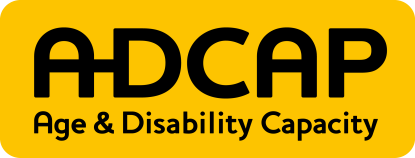 Developed by the Age and Disability Capacity Programme (ADCAP), the standards are designed to address the gap in understanding the needs, capacities, and rights of older people and people with disabilities, and promote their inclusion in humanitarian response. A pilot version was launched in 2018, with a revised version in early 2018.
Developed by the Age and Disability Capacity Programme (ADCAP), the standards are designed to address the gap in understanding the needs, capacities, and rights of older people and people with disabilities, and promote their inclusion in humanitarian response. A pilot version was launched in 2018, with a revised version in early 2018.
The Humanitarian Inclusion Standards provides specific interventions targeted at older people and people with disabilities, for better data and information management, to support their participation, to address barriers and to integrate age- and disability-sensitive measures into policies and programs.
Humanitarian Standards Partnership (HSP)
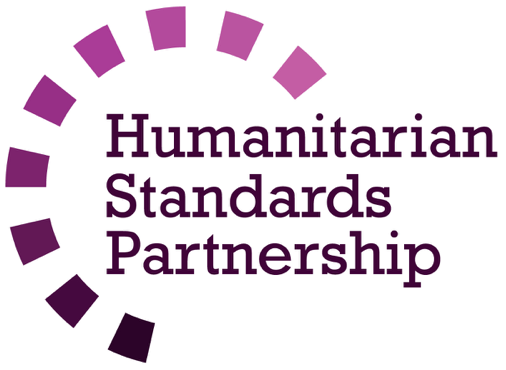 The HSP grew out of the Sphere Companionship model to promote implementation, complementary and coherence among technical standards. It encompasses the Humanitarian Charter, Protection Principles, CHS and Minimum Standards.
The HSP grew out of the Sphere Companionship model to promote implementation, complementary and coherence among technical standards. It encompasses the Humanitarian Charter, Protection Principles, CHS and Minimum Standards.
The Partnership provides guidance and evidence-based resources in nine key humanitarian responses: water and sanitation, shelter, food security and nutrition, health (Sphere); child protection (CPMS); economic recovery (MERS); education (INEE); livestock (LEGS); and market analysis (CaLP).
Minimum Standards for Mainstreaming Gender Equality
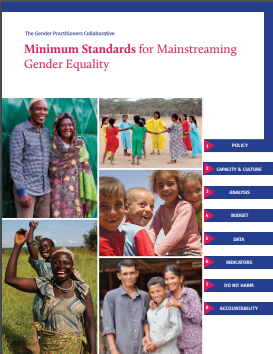 Endorsed in 2017 and developed by the Gender Practitioners Collaborative (GPC), the Minimum Standards for Mainstreaming Gender Equality sets internal and programmatic benchmarks from adopting gender equality policy and allocating budget resources to utilizing sex-and-age-disaggregated data and developing an organizational culture and capacity for gender equality. The intended outcomes are that organizations will share a common understanding to become “gender aware,” and be able to promote gender-responsive and gender-transformative programming.
Endorsed in 2017 and developed by the Gender Practitioners Collaborative (GPC), the Minimum Standards for Mainstreaming Gender Equality sets internal and programmatic benchmarks from adopting gender equality policy and allocating budget resources to utilizing sex-and-age-disaggregated data and developing an organizational culture and capacity for gender equality. The intended outcomes are that organizations will share a common understanding to become “gender aware,” and be able to promote gender-responsive and gender-transformative programming.
CHS Alliance Prevention of Sexual Exploitation and Abuse (PSEA) Handbook
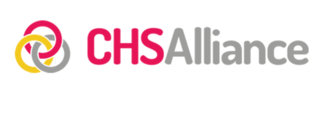 Initiatives to improve humanitarian sector safeguard standards are being taken forward this year. In 2017, the CHS Alliance published the Prevention of PSEA Handbook based on the eight areas covered by the IASC Minimum Operating Standards for Protection from Sexual Exploitation and Abuse for UN and non-UN staff. The Handbook takes these eight key action areas and provides examples and best practices of how to develop and implement PSEA measures.
Initiatives to improve humanitarian sector safeguard standards are being taken forward this year. In 2017, the CHS Alliance published the Prevention of PSEA Handbook based on the eight areas covered by the IASC Minimum Operating Standards for Protection from Sexual Exploitation and Abuse for UN and non-UN staff. The Handbook takes these eight key action areas and provides examples and best practices of how to develop and implement PSEA measures.
Child Safeguarding Standards to prevent sexual exploitation and abuse have also been developed by Keeping Child Safe in 2014.

